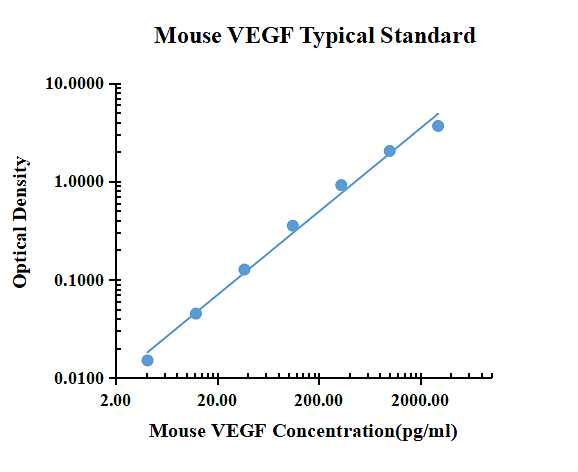Mouse VEGF enzyme-linked immunoassay kit
| Specification | 96 Test |
|---|---|
| Sensitivity | 0.57 pg/ml (10 μl) |
| Standard Curve Range | 4.12~3000 pg/ml |
| Standard Curve Gradient | 7 Points/3 Folds |
| Number of Incubations | 2 |
| Detectable sample | Liquid phase sample of soluble substances. For example: serum, plasma, cell culture supernatant, tissue grinding liquid, etc. |
| Sample Volume | 10 μl |
| Type | Fully Ready-to-Use |
| Operation Duration | 120min |

| pg/ml | O.D. | Average | Corrected | |
|---|---|---|---|---|
| 0.00 | 0.0084 | 0.0091 | 0.0088 | |
| 4.12 | 0.0241 | 0.0231 | 0.0236 | 0.0149 |
| 12.35 | 0.0557 | 0.0526 | 0.0542 | 0.0454 |
| 37.04 | 0.1373 | 0.1337 | 0.1355 | 0.1268 |
| 111.11 | 0.3702 | 0.3549 | 0.3626 | 0.3538 |
| 333.33 | 0.9362 | 0.9147 | 0.9255 | 0.9167 |
| 1000.00 | 2.0741 | 2.0273 | 2.0507 | 2.0420 |
| 3000.00 | 3.6762 | 3.6825 | 3.6794 | 3.6706 |
Precision
| Intra-assay Precision | Inter-assay Precision | |||||
| Sample Number | S1 | S2 | S3 | S1 | S2 | S3 |
| 22 | 22 | 22 | 6 | 6 | 6 | |
| Average(pg/ml) | 59.4 | 340.6 | 878.4 | 64.3 | 347.1 | 993.3 |
| Standard Deviation | 1.8 | 9.8 | 21.3 | 2.7 | 12.1 | 20.0 |
| Coefficient of Variation(%) | 3.0 | 2.9 | 2.2 | 4.2 | 3.5 | 2.0 |
Intra-assay Precision (Precision within an assay) Three samples of known concentration were tested twenty times on one plate to assess intra-assay precision.
Inter-assay Precision (Precision between assays) Three samples of known concentration were tested six times on one plate to assess intra-assay precision.
Spike Recovery
The spike recovery was evaluated by spiking 3 levels of mouse VEGF into health mouse serum sample. The un-spiked serum was used as blank in this experiment.
The recovery ranged from 114% to 131% with an overall mean recovery of 122%.
Sample Values
| Sample Matrix | Sample Evaluated | Range (pg/ml) | Detectable (%) | Mean of Detectable (pg/ml) |
|---|---|---|---|---|
| Serum | 30 | 16.98-45.87 | 100 | 27.58 |
Serum/Plasma – Thirty samples from apparently healthy mice were evaluated for the presence of IFN-γ in this assay. No medical histories were available for the donors. n.d. = non-detectable. Samples measured below the sensitivity are considered to be non-detectable.
Product Data Sheet
Background: VEGF
Vascular endothelial growth factor (VEGF or VEGF-A), also known as vascular permeability factor (VPF), is a potent mediator of both angiogenesis and vasculogenesis in the fetus and adult. It is a member of the PDGF family that is characterized by the presence of eight conserved cysteine residues in a cystine knot structure and the formation of antiparallel disulfide-linked dimers. Humans express alternately spliced isoforms of 121, 145, 165, 183, 189, and 206 amino acids (aa) in length. VEGF165 appears to be the most abundant and potent isoform, followed by VEGF121 and VEGF189. Isoforms other than VEGF121 contain basic heparin-binding regions and are not freely diffusible. Human VEGF165 shares 88% aa sequence identity with corresponding regions of mouse and rat VEGF. VEGF is expressed in multiple cells and tissues including skeletal and cardiac muscle, hepatocytes, osteoblasts, neutrophils, macrophages, keratinocytes, brown adipose tissue, CD34+ stem cells, endothelial cells, fibroblasts, and vascular smooth muscle cells. VEGF expression is induced by hypoxia and cytokines such as IL-1, IL-6, IL-8, oncostatin M, and TNF-alpha. VEGF isoforms are differentially expressed during development and in the adult.
VEGF dimers bind to two related receptor tyrosine kinases, VEGF R1 (also called Flt-1) and VEGF R2 (Flk-1/KDR), and induce their homodimerization and autophosphorylation. These receptors have seven extracellular immunoglobulin-like domains and an intracellular split tyrosine kinase domain. They are expressed on vascular endothelial cells and a range of non-endothelial cells. Although VEGF affinity is highest for binding to VEGF R1, VEGF R2 appears to be the primary mediator of VEGF angiogenic activity. VEGF165 also binds the semaphorin receptor, neuropilin-1, which promotes complex formation with VEGF R2.
VEGF is best known for its role in vasculogenesis. During embryogenesis, VEGF regulates the proliferation, migration, and survival of endothelial cells, thus regulating blood vessel density and size, but playing no role in determining vascular patterns. VEGF promotes bone formation through osteoblast and chondroblast recruitment and is also a monocyte chemoattractant. After birth, VEGF maintains endothelial cell integrity and is a potent mitogen for micro- and macro-vascular endothelial cells. In adults, VEGF functions mainly in wound healing and the female reproductive cycle. In diseased tissues, VEGF promotes vascular permeability. It is thus thought to contribute to tumor metastasis by promoting both extravasation and tumor angiogenesis. Various strategies have been employed therapeutically to antagonize VEGF-mediated tumor angiogenesis. Circulating VEGF levels correlate with disease activity in autoimmune diseases such as rheumatoid arthritis, multiple sclerosis and systemic lupus erythematosus.

